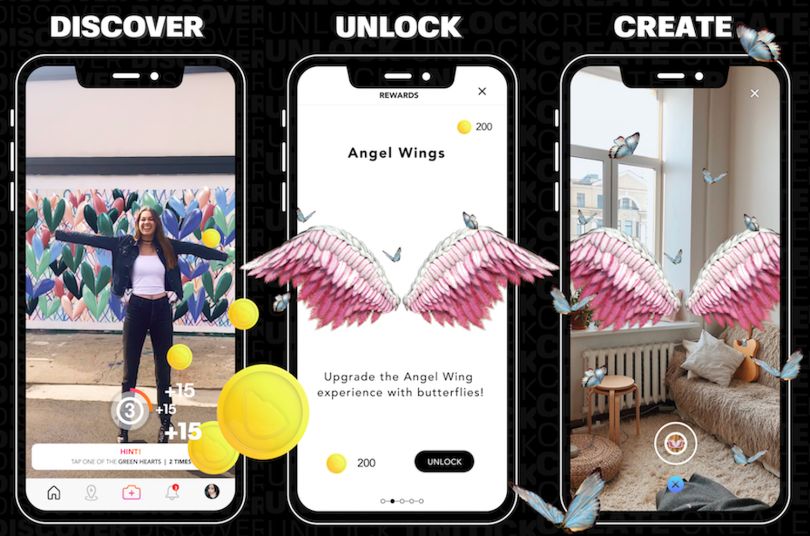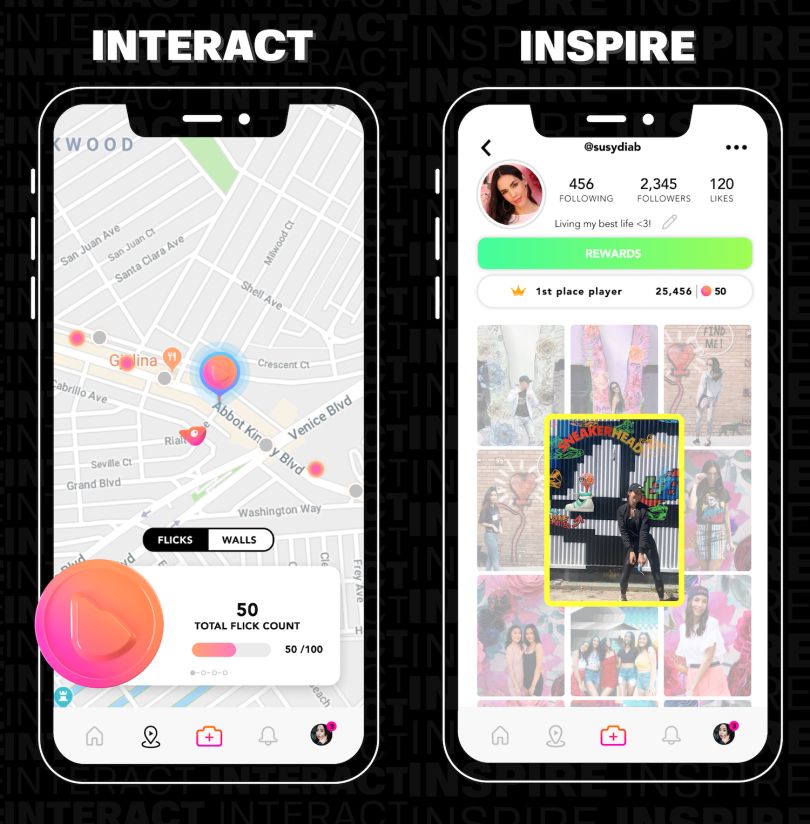Remember when malls were the place to see and be seen? Pierina Merino does. Or at least she’s aware of a time, not so long ago, when physical retail locations were more closely tied to social and cultural cachet.
Merino is the 29-year-old Venezuelan-born tech entrepreneur behind FlickPlay, a social media mobile app that incorporates 3D augmented reality animations into immersive videos. While she may not have been a teen in the golden era of mall culture, she views its decline as lamentable: an unfortunate consequence of the rise of e-commerce and social networks.
Apps like Instagram and Snapchat have done plenty of good, she told me, not least helping friends stay connected and providing avenues for people to express their creativity. However, the 2D close-up framing of their interface designs — ideal for communicating quickly with friends in selfie mode — have done little to activate the world around users.
This is where Merino, a former architect who worked in the studio of renowned Canadian architect Frank Gehry on projects such as Facebook’s Menlo Park headquarters, believes social media has room to innovate: the intersection between physical and digital space.
“In the ’80s and ’90s, kids were looking to have fun with their friends. It wasn’t only who was with you but where that was that informed status. But in the social medium, the online community is what makes you more popular,” Merino said.
She envisions FlickPlay as the next generation of social media, an outward-facing, immersive experience in which users’ videos become playable games whose social value is closely tied to culturally significant landmarks and retail sites.

It’s Like TikTok, but More Surreal
Available in the United States as an iOS app and set to launch in Spain in 2021, the app operates much like TikTok’s. The explore page features full-screen, looping videos set to music and often including people dancing or participating in challenges. There are options to like them, comment on them and share them via social channels. Swipe up and you are presented with new options.
But if TikTok’s user interface is focused largely on its subjects, FlickPlay’s attention is directed at the landscape around them. It’s the real world, but it’s a world made surreal by images floating through space or attached to people and objects, as if Salvadore Dalí or Jesús Rafael Soto dropped in on the party to orchestrate its visual effects.
The camera feature takes Instagram’s sophisticated video editing tools one step further, allowing users to select a range of animated 3D assets, from hypercolor laser stars and flapping angel wings to spinning ice cream cones and Starbucks cups. These can be manually added to scenes being captured on video and, once positioned and sized, they operate autonomously: swirling about the visual field or moving in timed, kinetic sequences.
“Virality of content requires repetition. When you see content over and over, it gains social relevance.”
Videos are synced with an interactive map, currently disabled due to COVID-19, which plots geotargeted locations where they can quickly gain popularity. Scavenger hunts, curated hashtags and integrated promotions through retail partners offer chances for rewards — from in-app currency to Burger King menu items. They also encourage viral sharing.
“Virality of content requires repetition,” Merino said. “When you see content over and over, it gains social relevance. That’s why the Hollywood sign gained relevance. People took pictures of it and shared them. The same with Cloud Gate in Chicago. But these are not the landmarks for today’s generation. My little cousin comes to LA to take videos next to a graffiti wall with vloggers.”
Part of the app’s appeal is its ease of use. Interactive videos that before would have taken hours and a fair amount of technical expertise to produce using motion graphics software and post-production tools like Adobe After Effects can now be achieved on a phone in a few taps and swipes.
When you open the camera icon on the lower rail of the homepage, the app serves up a library of experience packages, grouped by category. The UX is fairly straightforward. Select options for nature, sports, fairy tales or “trending” and the app downloads effects to embellish a “flick” (the technical term for when video cameras start to film).
Tap an option for “Ice-cream chillin,” for instance, and a floating pink ice cream cone appears on the screen. Pinching your forefingers and thumb together adjusts the image size. Dragging it up and down or left and right adjusts its position in the composition. Perhaps because these effects are unexplored terrain for some users, pop-up text instructions and hints are fairly explicit.
As a 43-year-old digital interloper, I had no problem populating my living room, as displayed on an iPhone, with floating ice cream cones.
Another interesting feature is the option to create multi-frame videos. When you start a “flick,” a slider bar shows you where you start and end a scene. A start and stop button makes it remarkably easy to stitch together videos from different places and visual perspectives into a single movie. Music is built into many of the experiences so you can create videos backed by artists like Avril Lavigne and Lady Gaga.
Once videos are shared within the app, the community can interact with them by tapping the app’s isotype, a pink chameleon positioned near the center of the screen. When selected, the button releases a group of moving white orbs. These can be touched to earn flick coins redeemable for rewards, such as personality badges, new visual assets and points on a trendsetter leaderboard.
When COVID-19 relaxes and the geotagged map goes back online, the augmented reality features are likely to become even more integral to the user experience.
“Imagine you’re walking in the trendiest part of Chicago, the Magnificent Mile or Millennium Park. A notification will let you know a FlickPlay experience is available 20 feet from where you are,” Merino said.
Then, when a user selects an AR experience and points their phone at a landmark on the app’s map, a light detection and ranging (LiDAR) signal from the camera, available on iPhone 12 models, will launch the asset. It will appear on the phone’s screen as though it existed in the physical world in a kind of three-dimensional hyperreality.
Imagine a giant three-dimensional visualization of tulips erupting from the Cloud Gate sculpture in Millennium Park or the parkway in front of a clothing boutique. That’s the kind of image you’ll be able to capture on your phone, earning flick coins in the process.

Influencer Marketing, Gamified
Merino said fashion brands like Dior, Tissot and Gucci have begun experimenting with AR as a way to interact with their clients. Entertainment brands are also prime candidates for early adoption.
Partners have access to a visual presence on FlickPlay’s interactive map, along with a dedicated profile page and opportunities to promote time-bound reward packages. Because videos can be shared to platforms like Facebook, Instagram, Snapchat and TikTok, they have the potential to be widely disseminated.
FlickPlay’s planned Spanish launch in February will be announced in partnership with a luxury beauty brand. While Merino declined to disclose the name of the company, she told me the move is part of a broader strategy to expand the role of social influencers at retail sites.
At the same time the app offers brands a way to advertise their products inexpensively, it offers perks for fashionistas, meme makers, fitness lovers and sports fans, who can get rewarded for creating and sharing content, whether by unlocking new app assets or earning paid affiliate partnerships.
This is hardly a novel idea; Instagram basically wrote the playbook for it. What’s different, though, is how these experiences are gamified.
“The next generation of consumer apps ... will be built by people who understand people and have an eye for how parts come together to create a 360-degree experience for users.”
Merino explained in a press briefing shared with Built In that “FlickPlay uses a freemium model that allows users to download apps and interact with some experiences at no charge. Users don’t need to pay for any experience so long as their capture coins. While users keep active in their interaction with the app, they will collect enough coins to unlock experiences and rewards.”
Alternatively, “users may pay for unblocking experiences, personality badges and other attractions. Thanks to brand partnerships with the platform, users can obtain limited-time bounties, rewards or exclusive experiences available to the whole community,” she wrote.
In conceptualizing where and how to surface new videos on an interface, the physical world becomes the guide for discovery. Walking down Venice Boulevard in Los Angeles, for example, will yield different experiences than strolling Melrose Avenue. Nearby friends and events will inform the choices users are likely to discover on the app.
In other words, space matters. The real world matters. Malls — or something like them — might once again matter.
“The next generation of consumer apps won’t be built by engineers,” she told Ronen Ainbinder in a recent podcast interview. “They will be built by people who understand people and have an eye for how parts come together to create a 360-degree experience for users. That’s obviously something that feels so far away. It takes an architect’s understanding of how digital, physical and technical pipelines come together to realize.”
The app’s user experience is undoubtedly breaking new ground. But is the world ready for FlickPlay?
The Entertainment Value Curve
Ravi Mehta, the former CPO at Tinder, writing for Reforge, explains that the success of social media apps can be plotted on what he calls the “Entertainment Value Curve,” a graph that defines their social and production value. He uses the graph to illustrate why TikTok is doing so well and Quibi fared poorly. Yet, its implications are far-ranging.
A key point is that our feelings about content depend on who is creating and sharing it. While the production value of Snapchat might be low, it offers an accessible environment where people are likely to create content and have conversations about it with their friends. This, in turn, fosters high rates of distribution.
“A friend doesn’t need to be as funny as Kevin Hart to make you laugh, but Kevin Hart couldn’t get away with standing on stage and telling your friend’s jokes,” Mehta wrote. “Snapchat is a great example of this — it’s funny to see your friends wearing a silly lens, but wouldn’t be nearly as funny to see that same lens on a stranger.”
While Quibi boasted A-list celebrities, he explained, few people were talking about it. TikTok, on the other hand, was built for sharing, with 15- to 60-second looping clips, a home screen with prominent buttons for “following creators, reacting, commenting, sharing, and mimicking the current video” and a democratized algorithm designed to give new users with few views or followers a fighting chance to go viral.
FlickPlay appears to be taking these lessons to heart. At the same time the app offers high production value, it creates social value by allowing videos to be easily created and shared, with algorithms rewarding videos that promote high rates of engagement.
“Opening the app for the first time and looking at content that matches your demographic, psychographic and social interests plays a crucial role in building product empathy.”
A slide deck FlickPlay shared over Zoom shows users grouped into two main categories — game lovers, ages 12 to 20 who are likely to be drawn to the content game, and content lovers, ages 20 to 30, who are likely to be more interested in trending experiences and access to premium content. The user journey moves from onboarding and video creation inside the app to collecting coins, unlocking rewards and developing retail partnerships.
A discovery page is the next step in the development cycle. Set to go live in December, it will curate experiences based on a user’s location, relevant trends and the people they follow. Other planned features will allow users to create regional challenges and rank users based on the popularity of their videos. FlickPlay is hoping for high engagement, with users viewing videos three to four times before swiping.
“Opening the app for the first time and looking at content that matches your demographic, psychographic and social interests plays a crucial role in building product empathy,” she explained by email. “Virality of content relies on multiple ingredients, such as cultural and social relevance, timing and the source.” Ultimately, “displaying the right content to the right user creates likability, shares and reactions from the masses.”
And who, after all, hasn’t wanted to visit Wrigley Field or The Art Institute of Chicago — real places in the real world — and do something memorable, maybe recreate a scene from Ferris Bueller’s Day Off with laser lights and a touch of surrealism?




